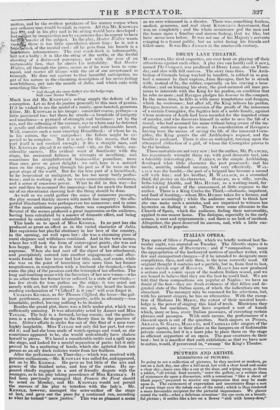PICTVRES AND ARTISTS.
EXHIBITIONS OF PICTURES.
IN going to see a collection of pictures, be they ancient or modern, go not on a dark day, nor after a full meal, but with a clear head and under a clear sky—leave care like a cur at the door, and wiping away, as from a tablet, "all trivial, fond records," enter the gallery, as a certain class of statesmen do upon a discussion, with a sensorium "like a sheet of blank paper," prepared to receive any impression that may be made upon it. The excitement of expectation and uncertainty flings a sort of warm tinge over the tabula rasa of the mind; which is thus rendered a more favourable recipient for the pictorial impressions. We glance round the walls—what a delicious sensation ! the eye rests on a beauti- ful picture; it settles like a bee on a flower "rich with honey-dew,"
and rifles its sweets without despoiling its beauties ; or it lilts away. butterfly, dazzled by brilliant colours and attracted by • rival charms, and so pursues .a wayward round of delight, flirting with the splendours of art and coquetting with the creations of genius. Then the mind, attuned, as by a harmonious symphony, enters upon the full fruition of enjoyment ; the degree and quality of which depend *holly upon the artists who furnish the feast of the sense. How often do the fair fruits of promise turn to ashes ! but then, not seldom do we "burst art's grape against the palate fine."
So much for our prelude. It will have been seen that we are not of the number of those who go with marked catalogues to look at certain pictures by certain painters. With us, it is not the name that makes the picture, but the picture that makes the name. The catalogue is good to refer to, for the title of the picture (though, by the way, it often spoils a good work, by showing that the artist either did not un- derstand his subject, or did not comprehend the virtue of what he had done), or for the name of a young artist ; to verify a surmise, or resolve a doubt—but no more. The visitor who is attracted merely by the title or subject of a picture will be soon tired of the tantalizing pursuit ; as those whose judgment is in leading-strings, and who pin their faith to great names, will be apt to pass by many a work of excellence pro- alitced by one "to fortune and to fame unknown." We endeavour to be the cicerone to our readers, and gently lead them to the best pic- tures ; but there are many worth seeing which the limited space we can ..devote to these luxuries, prevents us from pointing out individually: As a guide, we direct to the main track and the principal beauties, 'leaving the visitor to explore the lesser and more minute attractior,s. We have been led into this digression by .looking- over the catalogue taisonnee of the collection of Paintings by the Old Masters, illustrative of Scripture, exhibiting at Exeter Hall. Regardless of great names; as though we were looking at one of PHILLIPS'S collections for sale, we " stopped and looked, and looked and stopped, and stopped and looked again," where any picture took hold upon . our attention, and marked a few for especial notice : but, upon examining the catalogue so rich in sounding names and high attributes, we were Mortified by a dis- covery of our ignorance of the mysteries of. picture-dealing and con- noisseurship. This collection contains many fine paintings, of un- doubted originality ; but more curious and valuable as specimens of an- cient art, and as examples of the labour bestowed on their works by the Old Masters, than as illustrations of the subjects chosen. The merits of nearly all, in respect to detached parts,—such as carefully studied draperies elaborately painted, heads admirable for individual ex- pression and mastery of style, and, .above all, the intensity of purpose manifest in the work,—are of the highest character. Every admirer or fine pictures will find here a rich treat ; but the visitor who seeks for gratification independently. of the art pictorial, will be disappointed. To enumerate all the curious works, would be to quote the whole ca- talogue. There are, however, a holy Family, with a white rabbit in a landscape, by TITIAN—a Holy Family, by CARAVAGGIO—Lot and his Daughters, by Gmoo—Joseph and Infant Christ, by the same—a Judith, by MANFREDI—The Prodigal Son, by CALABRESE—Tobit mid the Angel, by GIORGIONE, which are beautiful, and display genius:and feeling, as well as the highest skill in art. An exquisitely carved cru- cifix in ivory,: by BENVENUTO CELLINI, • will be appreciated by every one. The most singular work of all—and it is as disagreeable as it is strange—is a picture by JAN STEIN, who revelled in bestialities, of Sainsodand-Dalilah, Wherein he has degraded the subject into the sink of his own mind, by substituting the lowest Flemish boors for the per- sons of the scene. The 'character and expression of each face is dis- gustingly true ; but Samson is the climax of the revolting. The cata- logue speaks Of the painter of this picture as "the humorous artist," and libels Hoomern by saying that "the story is told much in the way that he would have treated it,"—adding, that "it contains all the excel- lencies of the master :" this is like speaking of the perfume of a com- mon sewer.



























 Previous page
Previous page